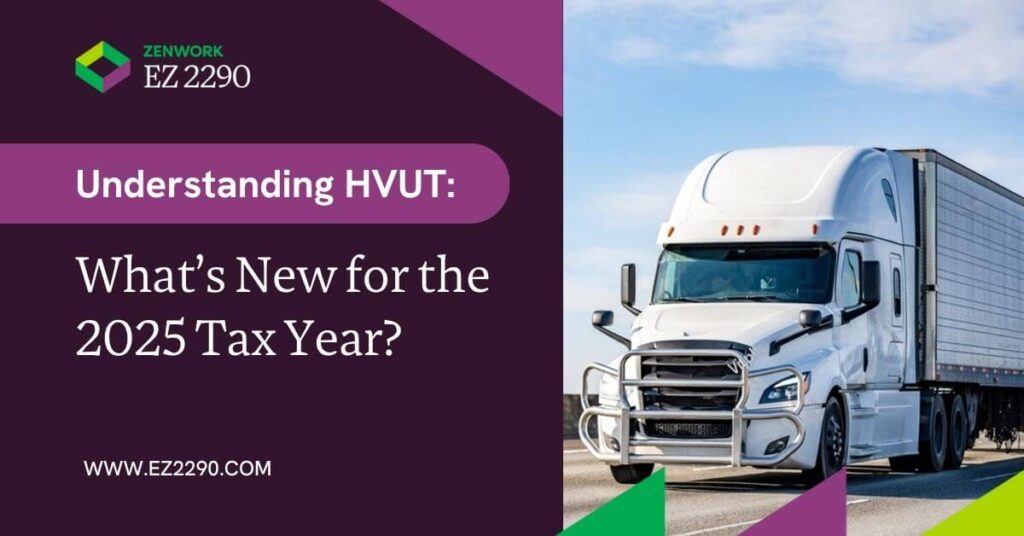If you’re operating a heavy vehicle over 55,000 pounds on public highways, the Heavy Vehicle Use Tax (HVUT) applies. It’s not new, but the details change every year. For 2025, there are a few important HVUT updates 2025 filers need to pay attention to. The IRS released its latest Form 2290 instructions in June, and if you’re not following those line by line, you could be staring down penalties, rejections, or delays.

The Basics: What Is HVUT and Who Has to File?
HVUT is an annual federal tax, and it’s assessed on heavy vehicles that operate on public roads and meet or exceed 55,000 pounds in gross taxable weight. This includes most trucks, tractors, and buses. Anyone who registers a qualifying vehicle in their name must file Form 2290 with the IRS.
You’re required to file Form 2290 each tax period (which runs July 1 through June 30) for any vehicle that was first used on a public highway during that period. The due date? It’s the last day of the month following the month the vehicle was first used. For vehicles first used in July 2025, your filing deadline is September 2, 2025. Why not August 31? Because it falls on a weekend.
HVUT Updates 2025: What’s New This Year?
Let’s get right to it. The biggest Form 2290 changes 2025 users will notice aren’t about the core tax structure, but the processes and enforcement. The IRS 2290 updates include:
- New emphasis on EIN validation timing. You must have an Employer Identification Number (EIN) that’s at least 4 weeks old before e-filing. If you just got an EIN, you might not be able to file electronically right away.
- Stricter enforcement of e-filing rules. If you’re filing for 25 or more vehicles, eFiling isn’t optional. IRS will reject paper forms from large fleets.
- VIN correction process has been streamlined. Previously, fixing a wrong VIN meant resubmitting and sometimes waiting. Now, some providers like EZ2290 let you file corrected forms instantly and without additional fees.
- Pre-filing supported by most IRS-approved e-file providers. For example, EZ2290 let’s you pre-file starting in early June 2025, which means you get your return in the system and ready to be processed once the IRS opens its e-file window on July 1.
These are the core HVUT updates 2025 filers should care about, especially if you’re managing a fleet or filing for clients.
2025 Heavy Vehicle Tax Changes: Rates & Suspensions
The actual tax rates haven’t changed. For reference:
- Vehicles 55,000–75,000 lbs: $100 base tax + $22 for each 1,000 lbs over 55,000
- Vehicles over 75,000 lbs: Flat $550 annual tax
Agricultural vehicles and logging vehicles may qualify for reduced rates or special status.
Vehicles that are expected to drive less than 5,000 miles (or 7,500 for agriculture) can be filed as “suspended vehicles” under IRS 2290 updates. But this isn’t automatic. You still have to file. You still have to report them. If they exceed mileage during the year, you’re required to amend your return and pay the tax.
One common mistake? Assuming no tax = no filing. That’s wrong. Suspended vehicles still require a filed Form 2290 with Schedule 1 showing the VIN and mileage category.
Form 2290 Changes 2025: Key Filing Notes
Here are some filing-specific details that are newly emphasized or clarified in 2025:
- EIN vs. SSN: The IRS will reject Form 2290s submitted with a Social Security Number. Only EINs are accepted. If you’re an owner-operator using your SSN, it won’t go through.
- Credit for destroyed, stolen, or sold vehicles: You can claim credits for these by reporting on Line 5 of Form 2290 or using Form 8849 with Schedule 6. However, you generally need to wait until the end of the tax period.
- Stamped Schedule 1: This is your proof of payment, and it’s required for state registration. If you e-file, you usually get this back within minutes. Paper filing can take weeks.
IRS 2290 Updates: Processing and Corrections
The IRS has started rejecting a lot more returns in 2025 due to incomplete or mismatched information. Here’s what’s causing problems:
- Name/EIN mismatches due to new EINs not yet recorded in IRS systems
- VINs that are invalid or formatted incorrectly
- Forgetting to check the correct month of first use
Also, corrected returns must now be submitted separately for changes in weight, mileage, or VIN. If you made a mistake on your original filing, don’t try to fix it by emailing someone or re-submitting the same return. Use the appropriate correction process.
HVUT Tax Law 2025: Compliance & Penalties
The penalties for noncompliance are real, and steep. If you fail to file Form 2290 by the deadline, you could be looking at:
- 4.5% of the total tax due, per month, for up to five months
- 0.5% of the total tax due for failure to pay
- Interest of 0.54% per month on unpaid taxes
If you submit a paper return when you’re required to eFile, that’s a rejection and a lost deadline. If you use the wrong EIN or forget to sign, your filing doesn’t count. It’s as if you never filed at all. That’s why understanding the 2025 heavy vehicle tax changes isn’t optional, it’s necessary.
Conclusion: Get it Right the First Time
The HVUT updates 2025 tax filers are dealing with aren’t about rates going up or major legislative reform. It’s more about how the IRS is tightening compliance and clarifying processes. The Form 2290 changes 2025 brought in are mostly procedural, but they matter. Especially for fleets and service providers trying to stay ahead.
Double-check your EIN. Use an IRS-approved eFile provider like EZ2290. Know your deadlines. And don’t assume suspended vehicles mean no paperwork.
If you’re still unsure, consult the updated IRS Form 2290 instructions released in June 2025 or talk to a tax pro. But don’t wait until August. That’s when mistakes get expensive.